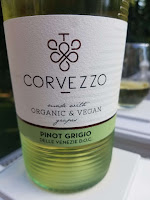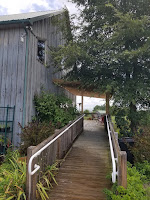 During our Spring trip to Croatia and specifically in the historic city of Osijek, I saw a poster advertising the Wine Tour Across Borders. The program has many sponsors but it centers upon the Tourist Boards of Osijek-Baranja County and Villany and obviously reflects the shared culture between the two regions. Baranya (Baranja in Croatian) translates to marshland in Slavic and the swampy region is bordered by the Drava and the Danube rivers and is divided by the Croatian-Hungarian border. Another translation of Baranya is "Mother of Vines and viticulture is robust.
During our Spring trip to Croatia and specifically in the historic city of Osijek, I saw a poster advertising the Wine Tour Across Borders. The program has many sponsors but it centers upon the Tourist Boards of Osijek-Baranja County and Villany and obviously reflects the shared culture between the two regions. Baranya (Baranja in Croatian) translates to marshland in Slavic and the swampy region is bordered by the Drava and the Danube rivers and is divided by the Croatian-Hungarian border. Another translation of Baranya is "Mother of Vines and viticulture is robust.  Up until the Treaty of Trianon, the two regions were joined together within the Roman Empire, the Hunnic Empire, the Kingdom of the Ostrogoths, the Kingdom of the Lombards, the Avar Kingdom, the Frankish Empire, the Balaton Principality, the Bulgarian Empire, the Kingdom of Hungary, the Ottoman Empire, the Habsburg monarchy, the Austrian Empire and the Austria-Hungary. After Trianon, the territories were split between Hungary and Yugoslavia.
Up until the Treaty of Trianon, the two regions were joined together within the Roman Empire, the Hunnic Empire, the Kingdom of the Ostrogoths, the Kingdom of the Lombards, the Avar Kingdom, the Frankish Empire, the Balaton Principality, the Bulgarian Empire, the Kingdom of Hungary, the Ottoman Empire, the Habsburg monarchy, the Austrian Empire and the Austria-Hungary. After Trianon, the territories were split between Hungary and Yugoslavia.  Living within these various empires and trade routes the multiple ethnicities combined aspects of various cultures (Hungarian, Croatian, Swabian (Germans), and Serbian). These influences include architecture, culinary dishes, and of course, wine grapes. Kekfrankos <=> Frankovka is obviously a shared grape, but since the regions lie near the infamous 45-degree latitude, many international grapes thrive in their vineyards: Cabernet Franc, Merlot, Pinot Noir, and Chardonnay.
Living within these various empires and trade routes the multiple ethnicities combined aspects of various cultures (Hungarian, Croatian, Swabian (Germans), and Serbian). These influences include architecture, culinary dishes, and of course, wine grapes. Kekfrankos <=> Frankovka is obviously a shared grape, but since the regions lie near the infamous 45-degree latitude, many international grapes thrive in their vineyards: Cabernet Franc, Merlot, Pinot Noir, and Chardonnay.  In northwestern Baranja, close to the Danube, the town of Zmajevac is located on the slopes of Baranja Mountain. For centuries, vines have been grown on Banova kosa, an elevation that stretches west-east along the entire region. Zmajevac grew out of the Roman colony of Ad Novas and the Romans called "kosa" the Golden Hill. The vineyards survived the various kingdoms and occupations and today several wine cellars are dug into the southern slope of the mountain with vineyards situated right above. The Turkish name for these cuts is "sarduk" while the wine cellars or houses are called gators. Within these cellars, the temperature remains constant between 53 and 59 degrees Fahrenheit. According to one of the top wineries, Josic Winery, "Sarduks are considered one of the most prominent original cultural and historical treasures of this part of Baranja". Looks very Hungarian to me.
In northwestern Baranja, close to the Danube, the town of Zmajevac is located on the slopes of Baranja Mountain. For centuries, vines have been grown on Banova kosa, an elevation that stretches west-east along the entire region. Zmajevac grew out of the Roman colony of Ad Novas and the Romans called "kosa" the Golden Hill. The vineyards survived the various kingdoms and occupations and today several wine cellars are dug into the southern slope of the mountain with vineyards situated right above. The Turkish name for these cuts is "sarduk" while the wine cellars or houses are called gators. Within these cellars, the temperature remains constant between 53 and 59 degrees Fahrenheit. According to one of the top wineries, Josic Winery, "Sarduks are considered one of the most prominent original cultural and historical treasures of this part of Baranja". Looks very Hungarian to me.  In 1999, the Osijek-based Josić family purchased a wine cellar built in 1935 and restored it by adding modern technology but keeping the original appearance. Simultaneously they purchased 1.6 hectares of languishing vines and a winery restaurant was established. Based on our visit, both are flourishing with the restaurant offering numerous river fish specialties such as perkelt, stewed fish, smoked fish - sometimes cooked over a spit, as well as the goulash, game, and other meat dishes.
In 1999, the Osijek-based Josić family purchased a wine cellar built in 1935 and restored it by adding modern technology but keeping the original appearance. Simultaneously they purchased 1.6 hectares of languishing vines and a winery restaurant was established. Based on our visit, both are flourishing with the restaurant offering numerous river fish specialties such as perkelt, stewed fish, smoked fish - sometimes cooked over a spit, as well as the goulash, game, and other meat dishes. Their food menu suggests wine pairings for each dish and we indulged in multiple courses - nine to be exact and paired with eight wines - with the duck perkelt and paprika fish stew the most memorable. There were several wines we anticipated such as Traminac, Grasevina, and a Frankovka blend, but they also offer a pleasant Pinot Bijeli (Pinot Blanc) and a solid Grand Cuvee (Cabernet Franc, Cabernet Sauvignon, and Pinot Noir) Yet, the standout wine was the 2018 Cabernet Franc -- aged 1.5 years in both barrique and bottle. Textured with layers of red fruit and juicy tannins. Interestingly the wine labels depict rare or endangered species of birds that live in this area with the original design signed by the academic painter Sabina Ostojić and the famous photographer Mario Romulić.
Their food menu suggests wine pairings for each dish and we indulged in multiple courses - nine to be exact and paired with eight wines - with the duck perkelt and paprika fish stew the most memorable. There were several wines we anticipated such as Traminac, Grasevina, and a Frankovka blend, but they also offer a pleasant Pinot Bijeli (Pinot Blanc) and a solid Grand Cuvee (Cabernet Franc, Cabernet Sauvignon, and Pinot Noir) Yet, the standout wine was the 2018 Cabernet Franc -- aged 1.5 years in both barrique and bottle. Textured with layers of red fruit and juicy tannins. Interestingly the wine labels depict rare or endangered species of birds that live in this area with the original design signed by the academic painter Sabina Ostojić and the famous photographer Mario Romulić. Kneževi Vinogradi or Prince's Vineyards is located southwest of Zmajevac and also has Roman roots. Locals also refer to it as Suljoš and it is one of the oldest places in Baranja. Belje Winery operates two facilities in or near the village of Kneževi Vinogradi. Their Old Cellar is the largest gator in Slavonia and was dug into the hill in the center of the village. It was first mentioned in 1526 in the descriptions of the Battle of Mohács where it was used as a stable. [This was an overwhelming Otttomen victory leading to the destruction of the Kingdom of Hungary and the first siege of Vienna.] 170 years later Prince Eugene of Savoy was awarded an estate between the Danube and Drava rivers after his victory over the Turks at the Battle of Zenta in 1697. [The Turks had been slowly retreating from the Pannonian Basin since the second siege of Vienna in 1683.] According to the winery, "At Belje, Eugene of Savoy built a castle and unified 19 surrounding villages into an agricultural estate where he developed crop husbandry and livestock breeding and in the village of Kneževi Vinogradi, where there already were large wine cellars, he built an irrigation system and planted grapevines".
 From that time the Old Cellar was expanded to three floors spanning 1,200 square meters. It holds wooden barrels made of Slavonian oak from the forests of Spačva and a wine archive containing 20,000 samples, with the oldest bottle, a Cabernet Franc, dating back to 1949. Recently Vina Belje built a new state-of-the-art, 10,000 sqm winery within the confines of their vineyards.
From that time the Old Cellar was expanded to three floors spanning 1,200 square meters. It holds wooden barrels made of Slavonian oak from the forests of Spačva and a wine archive containing 20,000 samples, with the oldest bottle, a Cabernet Franc, dating back to 1949. Recently Vina Belje built a new state-of-the-art, 10,000 sqm winery within the confines of their vineyards.  The wines from Vina Belje were very impressive, particularly those from their Premium and Goldberg brands. The Premium Blaufränkisch shows its suitability in the overall Baranya region and shows sherry notes with rich cherry fruit, slight spices, and noticeable tannins. The Premium Graševina is Belje’s most important wine and showcases the fresh green apple and bitter almonds characteristic of the Slavonian Graševina. The Premium Pinot Noir 2015 was the overall favorite with its integrated fruit (red and black fruit), a fresh mouthfeel, and structured tannins. A great selection of affordable wines -- all under $10.
The wines from Vina Belje were very impressive, particularly those from their Premium and Goldberg brands. The Premium Blaufränkisch shows its suitability in the overall Baranya region and shows sherry notes with rich cherry fruit, slight spices, and noticeable tannins. The Premium Graševina is Belje’s most important wine and showcases the fresh green apple and bitter almonds characteristic of the Slavonian Graševina. The Premium Pinot Noir 2015 was the overall favorite with its integrated fruit (red and black fruit), a fresh mouthfeel, and structured tannins. A great selection of affordable wines -- all under $10.Years ago we met the Swiss and German owners of the Heumann Winery at the Hungarian Embassy. They accommodate the Bordeaux style with the Terra Tartaro Meritage blend of Cabernet Sauvignon, Cabernet Franc, and Merlot while staying true to local grapes with an excellent Blaufränkisch.
Wines from Gere Attila Winery were being poured during a wine festival in Osijek from a booth advertising the Wine Tour Across Borders. This multi-generation organic winery produces several wines that are easily recognizable in Croatian Baranja. These include Kékfrankos (Frankovka ), Olaszrizling (Grasevina), Pinot Noir (Pinot Crni), and Cabernet Franc which is rebranded Villányi Franc. It was this Villányi Franc 2018 Csillagvölgy that was being poured at the festival - bright fruit, plenty of spices, and structured tannins.














































